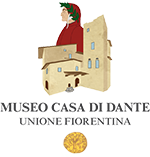DATE OF COMPOSITION
It has not yet been possible to establish precisely the year when Dante began writing the Divine Comedy, thus we have to rely on what we know about his life and on elements internal to the work. Certainly we should reject the hypotheses that a) Dante began writing the poem in honor of Beatrice before he went into exile and then finished it, after his sentence, starting in 1306, and b) that the Divine Comedy was begun after the death of Henry VII in 1313. Of the two dates now considered most probable, 1304 and 1306-1307, this latter seems most convincing, given that between 1304 and 1306 Dante was busy writing two other works (De vulgari eloquentia and Il Convivio), which he interrupted when the demanding work on the Divine Comedy began. Some historical references in the first canticle suggest that the Inferno was probably written by the end of 1309, while other historical information in the second canticle indicates that the Purgatorio was finished between 1313 and 1314. In 1316, Dante dedicated to Cangrande della Scala the first canto of the Paradiso, on which he worked up to the final years of his life.
General structure of the work
The Divine Comedy is divided into three canticles: Inferno, Purgatorio, and Paradiso. Each canticle consists of thirty-three cantos, except the first which has thirty-four, thus the entire poem is made up of one-hundred cantos.
Inferno
The kingdom of damnation is presented as an overturned cone, with its base lying underneath the hemisphere of the land surface and its tip reaching to the center of the earth. It is divided into ten zones: the Ante-Inferno and nine circles in which the souls are punished for their sins, moving from the least to the most grievous. After the first six circles, the seventh is divided into three sub-circles or rounds, the eighth into ten pits, and the ninth into four zones: Caina, Antenora, Ptolomea, and Judecca.
Purgatorio
The second reign of the afterlife is depicted as a mountain emerging from the hemisphere opposite the land surface. It is divided into three parts: Ante-Purgatory, Purgatory properly speaking, which is in turn divided into second terraces, and finally, at the top of the mountain, the Earthly Paradise.
Paradiso
The last kingdom of the poem reflects the Ptolemaic conception of the universe: it consists of ten heavens, each of which corresponds to a precise discipline. Starting from the planetary sphere closest to Earth, we find: the heavens of the Moon (Grammar), Mercury (Dialectic), Venus (Rhetoric), the Sun (Arithmetic), Mars (Music), Jupiter (Geometry) and finally Saturn (Astrology). Beyond the heavens of the seven planets is the heaven of the fixed stars (Metaphysics) and the crystalline heaven (Ethics), or the Primum Mobile, the ‘first moved’ that transfers its movement to all the spheres below it. Beyond the crystalline sphere is the unmoving heaven of the Empyrean (Theology).
Length of the journey
Dante tells that he traversed the three kingdoms of the afterlife during the spring equinox, starting on the night between the 7th and 8th of April of 1300, the year of the first Jubilee proclaimed by Pope Boniface VIII, and that he ended his journey at midnight of 14th April. It took the poet: one day and one night to walk through the ‘dark wood,’ a day and a night to travel through Hell, a night and a day to come back up from the center of the earth to the shore of Purgatory, three nights, three days, and another half day to climb the mountain of the second kingdom, and finally, twenty-four hours to visit the heavens of Paradise.
Description and meaning
Dante’s Divine Comedy, one of the most sublime expressions of world literature of all time, narrates in poetic form the journey made by the man Dante to the kingdoms of the afterlife in order to save his soul. Aided in traversing Hell and Purgatory by his guide Virgil, who represents reason, and Beatrice, the symbol of faith, Dante undertakes this journey after getting lost in the ‘woods’ of sin. By descending into the infernal world, climbing back up through the realm of purgation, and entering that of bliss, Dante effects a real purification of body and spirit. Nonetheless the Divine Comedy is also a ‘universal journey’: the purpose of his narrative, as Dante states in his Epistola a Cangrande, is to transport all of mankind from the state of misery to one of happiness.



